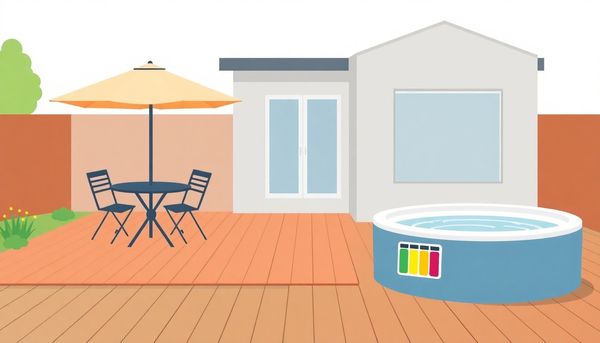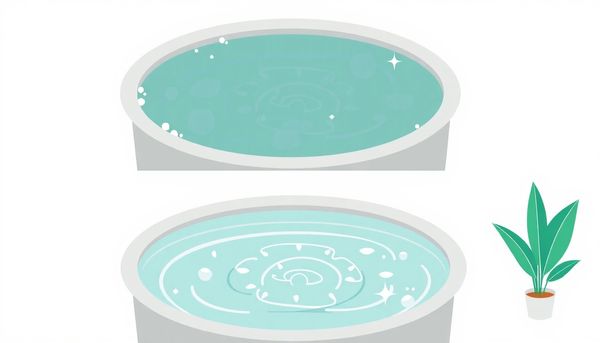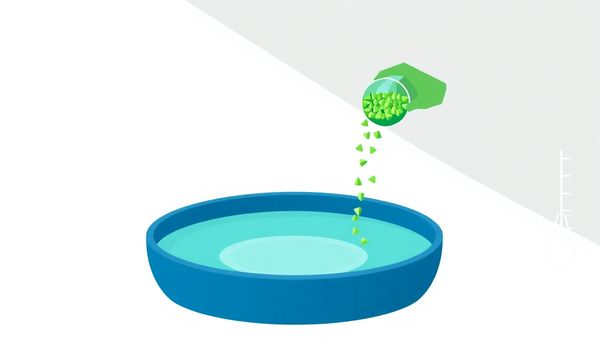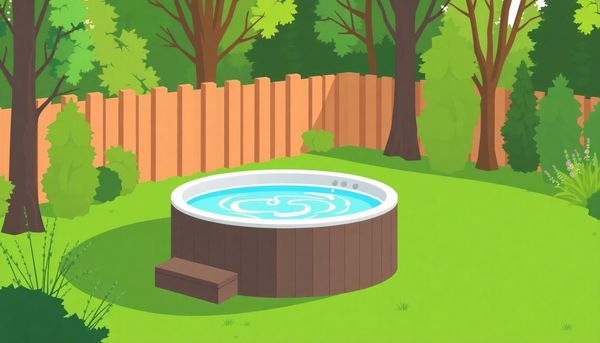Master Hot Tub Alkalinity: Tips for Clear, Balanced Water
December 19th, 2024
December 19th, 2024
Hot tubs offer a serene escape, a bubbling oasis where stress dissolves and relaxation takes hold. However, maintaining the perfect water chemistry is crucial for preserving this tranquility. One common challenge hot tub owners face is high alkalinity, which can lead to cloudy water, scaling, and ineffective sanitizers. Addressing this issue not only ensures the longevity of your equipment but also enhances the overall enjoyment of your spa experience.
Having battled this issue myself, I recall the moment I first noticed the water turning murky and the jets losing their vigor. It was then that I realized the importance of understanding and managing water chemistry. Alkalinity acts like a buffer, stabilizing the pH levels, but when it tips too high, it can spiral into a series of problems. Fortunately, with the right steps and a bit of patience, lowering alkalinity is entirely manageable.
This guide is designed to walk you through the process with clarity and confidence. From testing the water with precision to selecting the right chemicals, each step will be outlined with practical tips. Additionally, there's a video included, offering a visual companion to the written instructions, ensuring you can approach this task with ease. Whether you're a seasoned hot tub owner or a newcomer, mastering alkalinity will make every soak a delight.

Understanding why your hot tub's alkalinity is on the rise is key to maintaining pristine water. It's like discovering what’s behind the curtain before tackling the visible problems. High alkalinity can sneak in for several reasons, often rooted in the water source itself. If your home's tap water is naturally alkaline, it’s only a matter of time before your hot tub reflects the same trait. Another contributing factor is the use of certain spa chemicals or treatments, which might inadvertently tip the alkalinity scale.
Consider the products you use regularly in your hot tub. Some sanitizers and chemical additives, while effective at keeping your water clean, can also increase the alkalinity over time. Even the method of water treatment, such as using a chlorine shock versus a non-chlorine shock, can influence the water's chemical balance. Every splash and ripple adds its part to the bigger picture.
In my experience, the need to frequently top off the water level can also alter the alkalinity. As water evaporates, it leaves minerals behind, making the remaining water more concentrated in those minerals, thereby raising alkalinity. So, keeping an eye on how often you add new water, and understanding its composition, can help pinpoint potential causes. By knowing these factors, you can take informed steps to maintain the ideal balance, ensuring your hot tub stays both enjoyable and safe to use.
Understanding the interplay between alkalinity and pH in your hot tub is akin to mastering the art of balance. On a crisp evening, as you prepare to unwind, the water should neither sting the eyes nor feel as if it’s a lukewarm soup. Alkalinity, often misunderstood, serves as the invisible shield for your water's pH levels. Imagine it as the quiet guardian, ensuring that sudden shifts in acidity or basicity don’t rock the boat—or in this case, the tub.
Alkalinity, measured in parts per million (ppm), is essentially the water's ability to buffer pH swings. Ideally, this should sit between 100-150 ppm, providing a stable environment for your sanitizer to work its magic. If alkalinity drifts too high, not only does the water become cloudy, but your sanitizers, such as chlorine or bromine, may become ineffective. This scenario is akin to having bodyguards without armor—rendered useless by their lack of protective gear.
Maintaining this balance calls for strategic use of a pH decreaser, like sodium bisulfate. While it might seem counterintuitive to use a pH-focused product to manage alkalinity, the chemistry ensures it nudges both parameters gently toward harmony. By frequently testing and adjusting, you prevent the water from turning into a chemistry class gone wrong. These mindful adjustments keep your tub invitingly clear, ensuring that your evening soak remains a blissful retreat, not a frustrating chore.
Understanding why your hot tub's alkalinity is on the rise can save you from a cascade of water issues. It’s worth exploring the root causes before diving into solutions. A common culprit is the quality of the water source itself. If you’re filling your tub with water that already has high alkalinity, your battle begins before you even dip a toe. It's a bit like trying to navigate a maze that's constantly shifting—only this maze is filled with water chemistry instead of twists and turns.
Another source could be the meticulous use of certain chemicals. Products designed to raise pH, like baking soda, inadvertently boost alkalinity as well. It’s essential to differentiate between the two, as they often play a game of tug-of-war with your tub’s balance. Additionally, environmental factors like rainwater, which can introduce an unexpected chemical mix to your hot tub, might also be sneaking in.
Personal habits can’t be ignored either. If your hot tub becomes more of a community pool, increased usage leads to frequent chemical adjustments. Each small tweak accumulates, potentially pushing alkalinity levels up over time. Regular testing and understanding these sources can help you maintain harmony in your hot tub, keeping the experience relaxing and enjoyable, just as it should be. After all, who needs troublesome water when you're aiming for serenity under the stars?
Understanding how to effectively address high alkalinity in a hot tub can save you from unnecessary headaches and potential costs. High alkalinity might seem like a minor hiccup, but left unchecked, it can lead to cloudy water, reduced sanitizer efficiency, and even damage to your hot tub equipment. To tackle this issue, using a pH decreaser, commonly known as sodium bisulfate, is your best bet.
Before diving into the solution, it's crucial to know the water capacity of your hot tub. This determines the correct amount of pH decreaser to use. Generally, manufacturers provide a dosage chart, but a good rule of thumb is to start with a small amount and gradually add more, testing the water between additions. This careful approach prevents sudden drops in pH, which could otherwise lead to corrosion.
After adding the pH decreaser, let the hot tub circulate for at least 30 minutes and test the alkalinity again. Repeat the process if necessary, maintaining a total alkalinity range of 100-150 ppm—a sweet spot that ensures your water remains clear and your equipment functions optimally.
Once you’ve successfully adjusted the alkalinity, regular testing becomes your best friend. It helps catch fluctuations early, keeping your relaxing oasis inviting and safe. By taking these steps, you're not just preventing cloudy water but also safeguarding your hot tub investment for years to come.

No one enjoys a murky soak in the hot tub, and high alkalinity can be a silent saboteur, turning that dream into a cloudy reality. To tackle this, a pH Decreaser is your trusted ally. This magic potion, typically sodium bisulfate, is not just a one-trick pony for pH; it also skillfully manages alkalinity. The key is knowing how to wield it effectively.
First things first, get a handle on the size of your hot tub. Understanding the volume it holds is crucial for accurate dosage. Say your tub holds around 500 gallons; you'll refer to the instructions on your pH Decreaser for the recommended amount. This ensures you're not just winging it, potentially overshooting or undershooting, which could cause more harm than good.
Once you've measured the right amount, sprinkle it evenly across the water surface while the jets are running. This ensures thorough mixing and prevents the chemical from settling in one area. It’s a bit like evenly spreading toppings on a pizza to make sure every slice tastes just right. After adding the chemical, allow the system to circulate for 15-30 minutes, then retest the alkalinity. Adjust if necessary, being patient as the water finds its balance.
Through trial and error, and consistent testing, you'll become adept at maintaining that sweet spot of 100-150 ppm for alkalinity. This not only keeps your water clear but also prolongs the life of your hot tub components, saving you from frequent repairs and replacements.
Understanding the reasons behind high alkalinity in your hot tub is like uncovering the hidden culprits in a mystery novel. The story isn't just about the symptoms—cloudy water, ineffective sanitizers—but about the underlying causes that often go unnoticed. One frequent offender is the water source itself. If your municipal water supply has high alkalinity, every refill starts the cycle anew, making it crucial to test your source water right from the beginning.
Chemicals used to treat your hot tub can also contribute to the issue. Over-reliance on pH increasers or certain algaecides might do more harm than good. They can inadvertently tip the delicate balance, leading to elevated alkalinity levels. Regularly using a non-chlorine shock to maintain cleanliness can sometimes result in unexpected chemical interactions, further complicating the water chemistry.
Then there's the human factor. Frequent use, especially with multiple bathers, introduces body oils, lotions, and other contaminants that can interfere with water balance. It’s like throwing a party in your hot tub—fun but potentially messy. To prevent high alkalinity, incorporate a routine of frequent water testing and honest evaluation of how your current maintenance habits might be silently contributing to the problem. By addressing these potential causes, you can enjoy a clearer, more balanced soak without the drama.
Maintaining the optimal pH balance in your hot tub is akin to finding the sweet spot in a drizzling rain shower—not too much, not too little. Striking that perfect harmony ensures your hot tub remains a sanctuary rather than a chore. From my own experience, there’s nothing quite like the crystal-clear water that greets you after nailing the chemical balance.
The pH scale, a seemingly abstract concept, becomes tangible when you witness its effects firsthand. While pH measures your water's acidity or basicity, its feisty counterpart, alkalinity, acts as a stabilizing bodyguard, absorbing fluctuations that would otherwise send your pH level into chaotic swings. Keeping your pH between 7.4 and 7.6 is crucial, but without alkalinity in the range of 100-150 ppm, you're in for a yo-yo ride.
Imagine soaking after a long day, only to find your eyes watering and skin feeling tight. This discomfort often stems from improper pH levels, but with the right alkalinity, these problems can be preemptively curbed. Regular testing is essential; those quick dip strips can be your best friend in maintaining the balance. They test a multitude of chemistries, giving you a snapshot of what's brewing beneath the bubbles.
By regularly monitoring and adjusting your hot tub's chemistry, you protect not only your equipment but also ensure a blissful soak every time. Personal vigilance is your best defense against costly repairs and uncomfortable soaks.
Stepping into the world of hot tub maintenance can often feel like navigating a labyrinth, especially when faced with the challenge of high alkalinity. Choosing the right pH decreaser is a crucial step in maintaining that perfect soak. Not all pH decreasers are created equal, and selecting the wrong one can lead to more harm than good.
When shopping for a pH decreaser, sodium bisulfate is your best ally. It might sound like a mouthful, but this compound is specifically designed to lower both pH and alkalinity safely. Remember, your goal is to adjust alkalinity without throwing your water chemistry out of balance. A friend of mine learned this the hard way when she opted for a generic product that wreaked havoc on her hot tub’s balance, leading to endless cycles of adding and correcting chemicals.
Consider the packaging. Many pH decreasers come with clear instructions tailored for hot tub use, ensuring you add just the right amount. It’s worth spending a few extra dollars on a product that provides precise measurements and is formulated for the delicate ecosystem of a hot tub. Look for brands that are well-reviewed by other hot tub owners, as their experiences can guide you away from potential pitfalls.
In the end, your hot tub’s health is an investment in relaxation and peace of mind. By making informed choices and selecting a reliable pH decreaser, you can enjoy crystal clear water and a worry-free soak every time.

Have you ever wondered why your hot tub's water sometimes resembles a murky pond rather than a crystal-clear oasis? The culprit might just be lurking in the intricate dance between pH and alkalinity. While both are crucial to maintaining a healthy hot tub environment, they serve different roles. Think of pH as the mood of your water, indicating whether it's acidic, neutral, or basic. Ideally, you want your hot tub's pH to hover around 7.4 to 7.6, a sweet spot where everything remains harmonious.
Alkalinity, however, is the steadfast guardian of pH, ensuring these mood swings are kept in check. Acting as a buffer, alkalinity helps stabilize pH levels, preventing them from fluctuating wildly each time a splash is made or a new chemical is added. Measured in parts per million (ppm), maintaining alkalinity between 100-150 ppm is often recommended to provide a cushion of stability.
A personal experience brought this to life when I neglected my own tub's alkalinity, naively focusing solely on pH. Imagine my surprise when cloudy water and inefficient sanitizers became the norm. A quick adjustment of alkalinity, using a pH Decreaser, turned chaos into clarity. Understanding this balance is not just about clear water; it's about ensuring that your hot tub remains a safe and pleasant escape.
Have you ever found yourself bewildered by the terms "pH" and "alkalinity" while tending to your hot tub? Many hot tub enthusiasts, myself included, have faced this perplexity. Once, I eagerly rushed to adjust my tub's pH, only to realize that alkalinity played a much more significant role in maintaining water stability.
pH measures how acidic or basic your water is, ranging from 0 to 14, with 7 being neutral. Aiming for that sweet spot between 7.4 and 7.6 ensures comfort and efficiency. Alkalinity, however, is like the unsung hero—think of it as a buffer that mitigates pH fluctuations. Acting as the water's defensive line, it absorbs changes before they upset the pH balance, which could otherwise lead to skin irritation or cloudy water.
Unlike pH, which is sensitive and swift to change, alkalinity measures in parts per million (ppm) and ideally stays between 100-150 ppm in your hot tub. This range gives you more room to maneuver before pH starts to fluctuate wildly. It took me a while to grasp that alkalinity isn't just another number to control. It's a crucial factor that maintains harmony in the water. So, when your hot tub’s alkalinity levels seem out of sync, remember that it’s the key to a stable, enjoyable soak.
When it comes to managing high alkalinity in your hot tub, think of it like taming a temperamental beast. Too much alkalinity not only clouds your water, making it look unappealing, but it also undermines the efforts of your sanitizer. This can lead to green water and unpleasant surprises like algae blooms. Thankfully, a little chemistry can bring tranquility back to your spa haven.
Begin by grabbing a pH Decreaser, specifically sodium bisulfate. Don't be misled by the name—while it's known for tackling pH, it's your secret weapon against high alkalinity too. Before you pour, ensure you know the volume of your hot tub. This knowledge is key to avoiding overcorrection, which can tip the balance too far the other way.
A personal tip: make it a habit to test your water regularly with a reliable test kit. It will quickly become second nature, like brushing your teeth. When alkalinity strays above the recommended 100-150 ppm range, a sprinkle of your pH Decreaser should do the trick. Add it in small doses, retesting in between, to maintain a stable pH.
Keep in mind, consistency is your ally. Regular maintenance and water changes every few months prevent buildups and keep your hot tub in pristine condition. That way, every soak remains a soothing, not scaly, escape.
Balancing water chemistry in your hot tub is like being a conductor in an orchestra, ensuring each instrument plays in harmony. High alkalinity is a rogue flute, disrupting the symphony of your spa experience. When alkalinity levels soar, the water can become cloudy, and your sanitizers may lose their superpowers. To tackle this, arm yourself with a pH Decreaser or sodium bisulfate—your trusty baton in regaining balance.
Before diving into action, it’s essential to understand the unique roles of pH and alkalinity. pH measures the acidity or basicity of your water, while alkalinity acts as a buffer, protecting pH from rapid fluctuations. Imagine alkalinity as the sturdy foundation of a house; without it, the structure—your pH—would be unstable. Aiming for an alkalinity level between 100-150 ppm should provide ample cushion to maintain the ideal pH range of 7.4 to 7.6.
In my early hot tub days, I once faced the confounding issue of murky water. After some research, I discovered my alkalinity was off the charts. A few doses of pH Decreaser later, the water was crystal clear, and I had a newfound respect for this chemistry dance. Testing your water regularly, perhaps weekly, will keep you on top of any imbalances, making sure your hot tub remains a haven of relaxation rather than frustration.

Understanding the interplay between alkalinity and pH in your hot tub is crucial for maintaining a pleasant and safe soaking experience. Think of alkalinity as the unsung guardian of pH, silently ensuring stability. Without sufficient alkalinity, your hot tub's pH levels might yo-yo wildly, leading to potential damage to both the tub and the users. Alkalinity buffers the water, helping it resist sudden shifts in pH that could otherwise leave you stranded in a sea of cloudy water or with a tub overrun by scale and bacteria.
When alkalinity is out of balance, often sitting too high, it can hinder the effectiveness of your sanitizers like chlorine or bromine. This not only promotes the growth of bacteria but also leads to an efficient use of chemicals, causing unnecessary expenses. The trick lies in maintaining alkalinity levels between 100-150 ppm—a sweet spot that shields the pH while keeping the water crystal-clear. Testing strips or kits can offer quick insights into your water's chemistry, giving you the data needed to make informed adjustments.
Adding a pH Decreaser, often sodium bisulfate, can help lower high alkalinity. Yet, it's important to proceed gradually, adding the chemical in small doses and retesting. This patient approach helps balance alkalinity without plunging pH into the danger zone, ensuring your hot tub remains a relaxing retreat rather than a chemistry experiment gone awry.
Maintaining the perfect balance in your hot tub's water chemistry is a bit like orchestrating a symphony. When alkalinity takes the stage, it’s crucial to ensure it doesn’t overshadow the other players like pH. High alkalinity can render your sanitizer ineffective, leading to murky waters or the dreaded calcium scale build-up. To tackle this, a pH decreaser, often made from sodium bisulfate, becomes your best ally.
Imagine sitting by your hot tub with a bottle of pH decreaser in hand. Knowing the precise volume of your hot tub is essential, as it dictates the amount of decreaser you'll need. Start by sprinkling the recommended dose evenly across the water surface, akin to seasoning a dish. Allow the hot tub’s pumps to circulate the water for at least 30 minutes, giving the decreaser time to perform its magic.
Afterward, retest the water to ensure you've hit the target range of 100-150 ppm for alkalinity. This careful approach not only protects your hot tub but also ensures a comfortable and safe soaking experience. Remember, while a high alkalinity level is not common, it can still sneak up on you, particularly if regular maintenance is overlooked. Keep your pH decreaser handy, and your hot tub will thank you with clear, inviting waters every time.
There's a delicate dance happening in your hot tub, one that involves pH and alkalinity levels. Imagine these two playing a game of seesaw, where the balance is crucial for a smooth, enjoyable soak. Unlike the misunderstandings that often swirl around hot tub chemistry, pH and alkalinity aren't the same—though they are best buddies in maintaining water stability.
To put it simply, pH measures how acidic or basic your water is, aiming for the sweet spot between 7.4 and 7.6. Alkalinity, however, acts like a cushion against wild swings in pH, safeguarding the water from becoming too acidic. So, why does that matter? When alkalinity is too high, it can make your sanitizer less effective, allowing bacteria to thrive and potentially causing skin irritations or damaging the hot tub elements.
To bring those high alkalinity levels down, sodium bisulfate—a pH decreaser—comes to the rescue. This might seem counterintuitive since we're talking about alkalinity, not just pH, but trust me, it works. Just like when you're adjusting a recipe in the kitchen, you'll need to know how much water your hot tub holds to add the right amount of decreaser. Slowly introduce it, and monitor the levels with regular testing to ensure both pH and alkalinity fall within their happy ranges. Before long, you'll be back to soaking in crystal clear, perfectly balanced water.
High alkalinity often sneaks up on hot tub owners, bringing along unwanted guests like cloudy water and stubborn scaling. I remember when my friend Sarah, an enthusiastic hot tubber, called me in a panic because her once crystal-clear retreat had turned into a foggy mess. After a few questions, it was clear her alkalinity levels had surged. This scenario is more common than you might think. High alkalinity disrupts your sanitizer's efficacy, leading to murky water and potential bacterial growth. A reminder that maintaining the right balance is more than just a numbers game; it's essential for a healthy soak.
The remedy? Taming those alkaline levels with a pH Decreaser, often sodium bisulfate. While it might sound counterintuitive, balancing pH and alkalinity involves a delicate dance. Adding the pH Decreaser in small, calculated doses helps to reduce alkalinity effectively without sending your pH into a tailspin. Always retest after each adjustment to keep your water chemistry in check—this ensures you're not unwittingly trading one problem for another.
Preventing scaling requires vigilance. High alkalinity can lead to calcium buildup, making your hot tub work overtime. Regularly check your water's hardness and alkalinity levels to prevent scaling. By maintaining a routine of testing and adjusting, you create an environment where your hot tub can thrive, free from cloudy water and the burdens of scaling.

High alkalinity in a hot tub can sneak up on even the most diligent spa owner. A swift glance at your test strip might reveal levels more suited to a chemistry lab than your backyard retreat. Fortunately, preventing this issue is simpler than it seems. Begin by maintaining a consistent water care routine. Draining and refilling your hot tub every three to four months is not just a suggestion—it's your first line of defense. Fresh water resets the chemical balance, allowing you to start anew with a clean slate.
Moreover, always measure the alkalinity before adding any chemicals. Regularly testing your water is akin to a health check-up for your hot tub, catching potential problems before they escalate. I remember a friend who thought his spa’s water looked perfectly fine until his skin started feeling itchy post-soak. A quick dip with a test strip revealed the culprit: sky-high alkalinity levels.
In addition, be cautious when using products like baking soda. While it’s a handy tool in the kitchen, it’s notorious for raising alkalinity in hot tubs. Instead, rely on chemicals specifically formulated for hot tub use. Control any pH spikes that might prompt an alkalinity hike by using a pH decreaser in moderation. And finally, avoid using common household items like vinegar; these won’t tackle alkalinity and might throw your pH further out of balance. By taking these precautionary steps, you ensure your hot tub remains a haven of relaxation, not a source of frustration.
High alkalinity in a hot tub isn't merely a number on a test strip; it's a hidden culprit that compromises your cozy soak. Consider this: it acts like a stubborn bodyguard that refuses to let your pH balance flexibly adjust. While it may seem harmless, high alkalinity can weaken the effectiveness of your sanitizers like chlorine or bromine, essentially inviting unwanted guests like bacteria to your relaxation party. Cloudy water and calcium scale build-up are the unwelcome side effects, and they could make your hot tub feel more like a chemistry experiment gone wrong.
Now, what causes this sneaky rise in alkalinity? Several factors play a role. Hard water is often at the forefront, bringing in excess calcium that throws the balance off. Additionally, local water sources might naturally be high in alkaline minerals, starting you off on the wrong foot before your first bubble. Even the cleaning agents used for maintenance can inadvertently contribute to the shift in alkalinity.
Once, I found myself puzzling over why my hot tub was more frothy than refreshing. Turns out, our municipal water system was loaded with minerals. A simple test confirmed high alkalinity, and after some adjustments with a pH decreaser, the clarity returned. Staying vigilant with regular testing and understanding these underlying causes can save you from both murky waters and costly repairs.
Understanding the delicate dance between pH and alkalinity in your hot tub is akin to mastering a fine art. Each plays a crucial role in ensuring your hot tub remains a sanctuary of relaxation rather than a breeding ground for bacteria or a hub of irritation. Alkalinity, often described as the steadfast bodyguard, protects pH from erratic swings that could otherwise lead to murky waters or damaged equipment. Maintaining alkalinity levels between 100-150 ppm provides a sturdy buffer, ensuring your pH hovers within the ideal range of 7.4 to 7.6.
Experiencing high alkalinity can feel like an uphill battle, but it becomes manageable with the right approach. I recall a time when my hot tub's alkalinity soared unexpectedly. Armed with a trusty pH decreaser (sodium bisulfate), I tackled the issue head-on. A gradual addition, coupled with frequent water testing, became my routine. While soda ash might sound like the hero of this tale, it’s actually the pH decreaser that swoops in to save the day when alkalinity levels misbehave.
Navigating this balance isn't just about pouring in chemicals and hoping for the best. It's about understanding your hot tub's unique needs, adjusting with precision, and keeping a vigilant eye on those test strips. Regular maintenance ensures that both pH and alkalinity stay in harmony, safeguarding your hot tub's health and your peace of mind.
Unlocking the secrets of pH decreasers can transform your hot tub experience. Imagine stepping into crystal-clear water, free from the murkiness and irritation that high alkalinity often brings. The key lies in knowing exactly how and when to use a pH decreaser, typically sodium bisulfate, to maintain that perfect balance.
First, grab your trusty test strips or kit and measure your hot tub's current alkalinity. Once you've pinpointed your starting point, refer to the decreaser's instructions for the correct dosage. This precise step is crucial because too much or too little can lead to a frustrating cycle of adjustments.
Pour the decreaser slowly around the hot tub's edges while the jets are running. This ensures even distribution, allowing the chemical to seamlessly mingle with the water. Patience is your best friend here—let it work its magic for at least 2-4 hours before retesting. If adjustments are still needed, repeat the process in small increments.
Remember that every hot tub has its quirks. In my own experience, a friend's spa needed a couple of rounds of adjustment before its alkalinity finally settled within the ideal range. Yet, the persistence paid off, leading to an inviting soak every single time.
Keeping an eye on the alkalinity not only prolongs the life of your hot tub equipment but also ensures a more enjoyable and safe soaking experience. Balancing chemistry isn't just about numbers; it's about crafting the perfect watery retreat.

This article provided insights into maintaining your pool. Start your pool care journey today!
Want to become a pool maintenance expert? Our free Pool School course covers everything you need to know about pool care. From basic maintenance to advanced troubleshooting, you'll learn how to:
Join over 10,000 pool owners who have already transformed their pool care routine. Get started with our free Pool School course today!